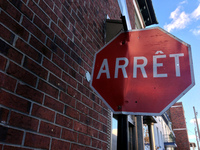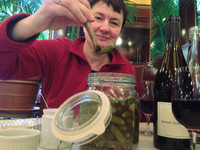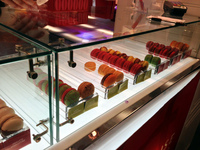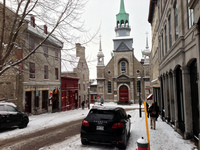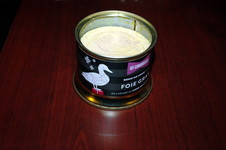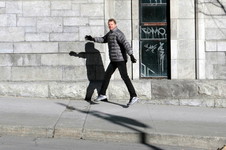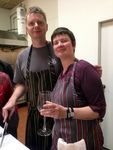 |
| Angelika/Mike Schilli |
|
|
|
Michael In December this year, we traveled to Canada. This time, we set out to explore the French-speaking part on the east coast and first had a stop-over after a five hour flight in Toronto. According to several previous experiences, Canadian immigration personnel are about the unfriendliest people on earth, and living up to our expectations, the person behind the counter greeted us this time by balking "What do you want in Canada?!" at us. Luckily, we know how to deal with this kind of situation. But, really, Canada?
When we asked our cab driver on the way from the airport to downtown Montreal if he spoke English, and we of course asked in French, he laughingly exclaimed: "No!" and we set out to explain that we only spoke very little French. The rest of the ride resumed in silence. I still remembered French numbers from school way back when pretty well, so I could at least tell him how much I was willing to pay for the ride including tip as we safely arrived.
We were truly shocked that except for a few American tourists everyone speaks French in Montreal. Every store you enter, the first thing you hear is "Bonjour!" and if you don't clue people in, they start throwing French at you at a speed that is really hard to understand for non-native speakers. For what it's worth, I have spent a solid five years of my life learning French, in a high school in Germany from 7th to 11th grade, four hours a week. Admittedly, French in school never resonated with me and I ended up with barely passing grades, but this illustrates fairly well that there's certain areas where the German education system went right by me without much effect.
But if the visitor then carefully inquires if their vis-à-vis might perhaps speak English ("Parlez-vous Anglais?"), it turns out that every native under 30 does so fluently. We found out that apparently French-Canadians get upset when visitors automatically assume that everyone speaks English. It seems a bit strange, but, hey, when in Rome.
Another oddity are the store opening hours, which are rather European than American. For example, we went to this grocery store right by the train station, and knowing they might be closing early on a Saturday, we inquired about how long they were open, and learned while gnashing our teeth that they would close at 5pm. To make sure we still would be able to get our groceries for the weekend, we showed up at 4:15pm and saw to our surprise that the meat counter was virtually sold out and the cheese fridge had already been covered up with protective tarp. Luckily, we had been there the day before, knew where everything was located, and were able to direct a sales person to the sealed-off areas in order to get a few items for our evening meal.
In one store, we inquired if there was a bakery nearby. All the clerks stuck their heads together, and started a lively discussion in French. After some back and forth, from what we understood there were several shopping malls that were evaluated, they concluded that it was too complicated to explain, and no, they were sorry, but they couldn't tell us where the next bakery was. Wha-what? We found this quite strange, because, I mean, if someone asked us in downtown San Francisco where the next bakery was, most likely we'd be scratching our heads a bit because high rents typically drive bakeries to the outskirts, but we would certainly be able to give directions on how to get to the nearest location.
And having lived for decades in the United States, we noticed a few stunning small differences in the French part of Canada: Sales clerks handling food aren't wearing gloves like back in the States. When we dined at a really good French bistro in Montreal one day, the waiter placed a gigantic jar with pickles on our table, and we extracted as many gherkins as we liked by using a pair of big wooden tongs provided for this purpose. When we were done, the waiter took the jar away, only to set it down at a different party's table! This would never fly in the U.S., the health department would start issuing violations and patrons would freak out! As born Europeans, we liked it, of course.
In the excellent "Beaver Hall" restaurant, named after the street it is located on, the waiter placed a whole loaf of bread on our table after we ordered, and put a gigantic bread knife with a serrated blade next to it. Imagine that to happen in the U.S., the restaurant owner would certainly worry about clumsy or reckless guests injuring themselves and having to deal with the resulting liability issues and million-dollar lawsuits!
Across the board, dining in the French part of Canada is a truly eye-opening experience, the food was truly excellent whereever we went. It's not exactly cheap but well worth the money, and the patrons are dressed up much fancier than in the U.S., although you can only tell after they've taken off their puffball-sized down jackets, which the waiters quickly put away to place them in the coat check area.
Another French specialty are the so-called "Macrons". Those two-layered cookies feature fillings of all kinds of flavors, and they're packed into small cardboard boxes by the dozen. Allegedly, they're really complicated to make, which is why, so the rumor goes, one cookie the size of a postage stamp costs more than a dollar. They're not bad, but I'd hardly drive all the way up to Canada to taste them. The sales person packs exactly one dozen into a small rectangular box, and if they don't fit all in, they're being squeezed until they do.
After three cold, but sunny days (always around 32F), all of a sudden, one morning, there were four inches of snow on the ground. We had done our homework and brought our Alaska gear to Montreal, so we just bundled up and grudgingly trudged through the slushy snow on the sidewalks. Interestingly, traffic was largely unimpacted.
When it comes to retailing alcoholic beverages, Canada features some of the most absurd regulations known to man. Details vary from state to state, so for example in the city of Montreal, located in the state of Quebec, supermarkets are legally allowed to sell wine and beer, but no hard liquor. A government-controlled store chain named "SAQ" (Société des alcools du Québec), on the other hand, offers wine, beer, and hard liquor in a somewhat elevated price category. Their store hours aren't exactly customer friendly, though, for example, they're closing at 5pm on Sundays!
Restaurants often have a liquor license, but many don't, and by displaying a "Apportez votre vin" sign, they're inviting customers to bring their own wine, usually purchased from a nearby store. Unlike in the U.S., they usually don't charge a "corking fee". It's a very good deal, as wines that cost $10 retail a bottle are often listed for $50 on the wine menu.
As you might know, selling foie gras in California has been outlawed about a year ago (Rundbrief 11/2012). Other states, for example Nevada, still offer it, and, as you've probably guessed, it's a staple on the menus in many French Canadian restaurants. Whenever the government takes something away, the natural reaction is to crave it, and when we saw that $25 can of foie gras on a christmas market in Montreal, we had to get it. Applied as spread on cruncy European-style bread sold at the "Premier Moisson" bakerey which, against all odds, we managed to find anyway, it tasted fabulous.
